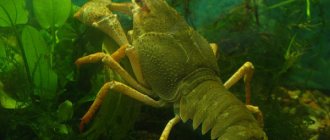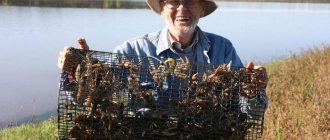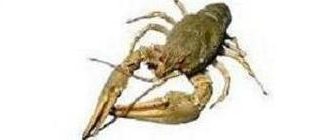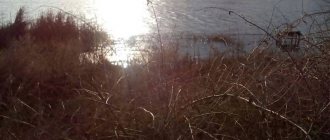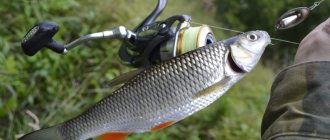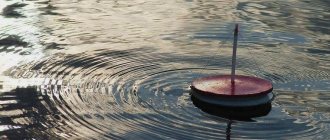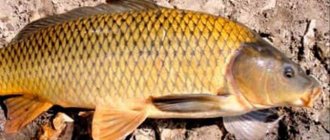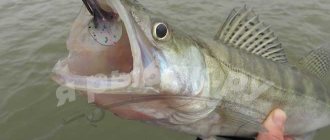Habits of crayfish
Crayfish prefer to live in clean water. If a body of water was found in which they are present, this indicates the environmental friendliness of this place. Crayfish are a desirable catch, no less popular than fish. Everyone likes the taste of crayfish; this is the product that people love to snack on with beer. In addition, crayfish are used as bait when fishing.
The length of a large specimen without claws can reach up to 20 centimeters, and the weight of an adult varies between 150-200 grams. Catching such a cancer is a great success. In most cases, crayfish fishermen manage to catch medium-sized specimens – 10-12 cm in length.
Crayfish habitats
Cancers are considered loners. They prefer to live on a rocky bottom, where they can easily find a secluded place, or on muddy surfaces - here crayfish can easily dig a hole for themselves. Crayfish burrows are located near the shore; they are narrow dwellings with a long corridor, no more than 1 meter long.
During the daytime, the crayfish sits in a hole, closing the entrance with its claws. To search for food, it comes out at night or in the afternoon in cloudy weather. The peculiarities of its existence are taken into account when hunting.
The best places to catch crayfish are:
- Shell rock. This is a place where crayfish often settle.
- Thickets of reeds. People don’t swim there and there are no animals, so crayfish can easily set up their home.
- Sandy bottom. Ideal fishing environment. There is a clean bottom and fine sand, making it easy to distinguish prey.
- Quiet creek with snags and tree roots. It’s very convenient for a crayfish to hide here, but a crayfish fisher who easily navigates the terrain can easily catch it.
- Rocky bottom. Here, crayfish set up their burrows, and therefore you will be able to find a lot of prey.
Time
Every crayfisher who decides to go hunting should know what time to catch crayfish. This is necessary in order not to waste your personal time. Crayfish are caught in the dark, when they go for prey - from 22-00 to 3-00. There are reservoirs where crayfish go out in search of food in the early morning.
It is difficult to answer clearly what time to catch crayfish, because different regions have their own deadlines. It is believed that you can catch delicious crayfish in the autumn. It is from the end of August to the end of October that crayfish have delicious and fatty meat. But in the spring, during spawning, catching crayfish is prohibited by law.
Where to catch crayfish
First, you need to decide where to fish, although you don’t really have to decide here if you know where crayfish are found in the summer. They remained approximately there in the fall, and that’s where you need to look.
The best option is the coastal zone, no more than five meters from the shore of your reservoir; they simply do not crawl further.
If you don't know where crayfish are found, your search may not be the most effective. Since the period of activity occurs in the early morning and late evening, that is, nothing special can be distinguished under water during these periods, and an angler can only afford to try at random with a huge supply of time and patience.
Thus, in order to understand where to fish you need to clarify the territory where their burrows are located. Coastal space. It’s better, of course, to choose one where you can sit comfortably and light a fire; you’ll understand why later.
When is it prohibited to catch crayfish?
Bans on catching crayfish in different regions of Russia are determined by the relevant government agency. Below are some examples of restrictions on fishing for freshwater creatures:
- From April to June, crayfish are not caught, as the law prohibits it. This is spawning time.
- It is completely prohibited to catch arthropods in Krasnodar and all surrounding rivers.
- From October to June, a ban on catching crayfish is in effect in the Vladimirov region.
- From October to June, crayfish hunting is prohibited in the Kirov region.
- In the Moscow area and in the region, year-round fishing for crayfish will not work.
- In the Orenburg region, from June 5 to July 15, there is a ban on catching arthropods.
- In the Kursk region, hunting is prohibited from the beginning of October until the end of June.
- In the Pskov region, it is impossible to catch arthropods from the moment the ice melts until mid-July.
Features of baits for catching crayfish
A common bait is fish. This is due to the fact that you can either catch it or buy it without any problems. In addition, fish is included in the diet of crayfish. The bait should be elastic and have a strong odor. In order for the smell to be clearly expressed, the fish carcass is cut, and part of the skin is also torn off. You don't have to use a lot of fish to catch a lot of crayfish. It is enough to provide conditions so that the crayfish cannot eat the bait prematurely.
In addition to dead bait, you can also use live bait. All you have to do is find a snail or shell and place it in a shell trap. In addition to them, a small frog will also go, which may interest the crayfish. Despite this, many crayfish anglers do not use live bait, and such fishing is questionable.
Garlic bread works well. The pungent smell of garlic attracts crayfish, and the bread serves as a kind of filling.
- Small fish or parts thereof are quite suitable; the fish can be slightly dried in the sun;
- You can use shellfish and snails;
- small frogs are suitable;
- Crayfish like pieces of meat.
Fishing methods
Due to the fact that today it is popular to catch crayfish with lines, few people use other fishing methods or even forget about them. But there are many options that are used to catch arthropods. Not all methods are easy enough, but this is what makes crayfish hunting so interesting and exciting.
Fishing with a crayfish
Catching crayfish by hand is prohibited by law, so it is recommended to use a crayfish catcher, which is quite easy to use. Typically, several types of crayfish traps are used simultaneously to increase the chance of catching crayfish. The design is made in such a way that arthropods get in there and cannot get out. And in order for them to get in there, they use bait that attracts crayfish.
Due to the fact that crayfish prefer to burrow in steep, steep banks to build burrows, the structure is installed near the coast. This is done like this:
- They take a long, strong stick, at one end of which there is a slingshot.
- The cord from the crayfish catcher is hooked with a slingshot so that the structure rises.
- The shell is slowly lowered into the water until it touches the bottom.
- The cord is tied to reeds, a stick stuck into the bank or any strong tree.
At night, crayfish come to the shore, so you should not throw the crayfish trap too far.
How to fish with a fishing rod?
This option is not easy, because crayfish are not fish, they just don’t bite the bait. Moreover, in the dark it will be difficult to attach the bait. For these reasons, there is only one way out - to catch crayfish with a fishing rod during daylight hours, but closer to sunset. It is recommended to choose a crawler, dung worm, rotten meat or fish as bait. The best time to catch crayfish with a fishing rod is from September to October.
It’s easier to catch crayfish with a classic fishing rod during the feeding season. For a larger catch, it is advisable to tie several hooks to the fishing rod at once, which will increase the likelihood that several crayfish will bite. Arthropods bite very slowly, but the crayfish will immediately feel the bite: the crayfish grabs the bait and drags it, while the float first moves smoothly to the side, and then sinks and hides in the water. Due to the fact that the crayfish does not cling to the bait very tightly, pull out the fishing rod carefully.
Screen efficiency
It is popular to catch crayfish with a screen, which is a round or square structure with sides that prevent the crayfish from falling out when removed from the water. For a good catch, 2-5 screens will be enough. The design of the screen is similar to a conventional clamshell, but differs in its rectangular shape.
They take steel wire, from which they make two squares, then they are fixed at a distance of 20-30 centimeters from each other, then they cover the bottom and side walls of the screen with mesh. Crayfish will crawl through the open top for bait. The screen is tied to a thick pole, which will act as a fishing rod, bait is placed in the center, and the screen itself is carefully placed in the water.
In November for crayfish
- home
- Archive
- RKG
- In November for crayfish
Andrey Mordyakhin, Nizhny Novgorod
FISHING ALL YEAR ROUND No. 23(85), 2005
Having completed the autumn season with spinning fishing, many anglers begin active preparation for the new one. Sooner or later, preparations for the upcoming fishing end, and the fisherman, for the umpteenth time going through the gear bought the day before, still can’t wait for the ice to finally appear on the river or lake and he will be given the green light. Or maybe we shouldn’t wait for mercy from nature, maybe we should try to fish in the conditions that she herself offers us? These are the thoughts that tormented me during the off-season.
Deciding to drive away the encroaching apathy, I’m going fishing. Well, even if the ice hasn’t stopped yet and it’s too late for spinning, I’m not going for fish, but for crayfish!
I haven’t had the opportunity to catch crustaceans very often. Basically, all attempts to catch crayfish occurred in the summer, when in warm water it was possible to search for them in burrows all day long.
Now it’s November, and the water is far from warm, it’s not painful to dive, so I use homemade crayfish traps as gear for catching crayfish. The gear consists of the following: a mesh with a small pocket is attached to an ordinary metal rod 5 mm thick, bent into a hoop with a diameter of 400 mm, in the center of which a bait is installed, the role of which is fresh-frozen fish. So that the placed rachens can be easily found on the surface of the water, a small piece of polystyrene is attached to them. Since fishing takes place in the dark, you simply need to have a flashlight with you so that when checking the crayfish traps, you can inspect their contents for any crayfish that you have caught.
Arriving home after work, we quickly change clothes, collect all the necessary gear and go to the bank of the Oka River. Once in place, we begin the process. We bait the crayfish with pieces of freshly frozen fish and place them along the shore at a distance of five meters from each other. Having placed the gear on the crayfish, the comrade casts four donks, hoping to catch a burbot. The bait used were crawlers and small ruffs that were caught on the eve. Having loaded all the gear, we make a fire, which with its bright flame illuminates the coastal darkness and warms our chilled bodies from the cold and wind.
After forty minutes, which we spent in complete silence, looking at the fire and listening to the sound of the oncoming waves, we began checking the crayfish traps. The first three tackles were empty, but the last two caught a pair of small crustaceans, which, having been photographed, were immediately released back into the river. Having finished checking the crayfish traps, we begin to inspect the donks. Having pulled all the odds and ends ashore and found nothing on them except ruffs, we throw the gear back and return to the fire.
Around the fire, while talking leisurely about the upcoming winter fishing, time flew by, and we had to go check our gear again. This time all the villages were empty. And the donks baited with ruffs remained untouched.
Meanwhile, upon our return, Denis had built the fire so hot that it began to illuminate not only the shore, but also the water a few meters away. Remembering that crayfish go to the light of a fire at night, my friend and I decided to move the camps closer to the fire.
Looking at us, Denis, also guided by this rule, rearranged his donks. I wonder if the theory that fish and crayfish come close to the shore in the light of a fire will be confirmed?
After waiting another hour, we check the gear. We take out several quite decent crayfish from the crayfish traps! So they really go into the light, but what about the fish? Having checked the donks and not finding a single ruff on them, we scratch our heads and try to give an explanation for this. Maybe they flew off during casting, or maybe when they pulled out the tackle to check. It is possible that they freed themselves from the hook, or maybe someone stole them?
Unfortunately, there were no more live bait left, so we were not able to test the theory of light, which concerned the fish. But we have now found the key to catching crayfish at night, which will allow us to cook more than one pot of this delicious delicacy.
Andrey Mordyakhin, Nizhny Novgorod
FISHING ALL YEAR ROUND No. 23(85), 2005
What to feed the crayfish?
Bait for catching crayfish is selected based on the time of year. In spring and summer, the use of bait of plant origin is effective. In autumn and winter, crayfish are lured with animal food. For these purposes use:
- trimmings of meat, poultry or fish entrails;
- fish;
- worms;
- shellfish;
- frogs;
- meat;
- snails
Fish is used fresh or spoiled. In order for the bait to release a more pronounced aroma, the product is initially dried in the sun. Cancers like bream, roach and crucian carp. For meat baits, it is advisable to give preference to a poultry carcass or a piece of beef. It is acceptable to use stale meat. It is better to catch frogs, snails, and mollusks in the same body of water where you plan to catch crayfish. Worms are a last resort option; they are placed in gauze to prevent them from spreading.
Among plant foods, the following are considered effective:
- corn;
- dill;
- peas;
- black bread;
- makukha;
- garlic
Peas and corn are pre-boiled, steamed or used in canned form. When choosing bait, the season is taken into account. With the onset of cold weather, arthropods are lured out with rotten meat or peas. In spring, use fish or vegetable bait. In summer, when it is very hot, the best option is a piece of liver, meat or chicken giblets. To enhance the smell, add a little fish oil.
It is equally important to choose the right place for catching crayfish, based on which you will be able to accurately select the bait. For example, to catch crayfish in reservoirs with muddy bottoms, spoiled fish are used as bait. For arthropods living in such conditions, this is considered a common food. They will crawl into the trap without feeling any danger. If there is a lot of vegetation on the bottom, crayfish choose peas or corn for fishing.
If the hunt takes place in underwater caves or under the shore, it is advisable to use complementary food with a strong aroma, for example, spoiled meat or a mixture with the addition of garlic. In shallow water, it is effective to use corn, worms or clams.
The best bait for catching crayfish is considered to be the bait you prepare yourself. Several effective recipes have been proposed that are used by experienced crayfish fishermen:
- Garlic bait. Grate or crush the garlic. Cut the rye bread into pieces and fry a little in oil (optional). Crush the garlic inside the bread and rub the crust with it. Garlic balls will be no worse. To prepare them, both garlic and rye bread are passed through a meat grinder, and small balls are formed from the resulting mass. Next, they are placed in nylon or gauze pockets - this will prevent the balls from becoming soggy in the water.
- From the top. Cut the pressed sunflower seeds into medium pieces, then add fresh or dried dill and rye bread to them. Mix thoroughly and add the mixture to the gauze.
- Fish bait. Before preparing the bait, fish are caught from the reservoir where arthropods are found. It is also acceptable to use freshly frozen store-bought fish. An incision is made along the ridge, the air bubble of the fish is squeezed out or pierced. The scales are lightly picked, and the crucian carp is completely removed. Small fish are used whole, and large fish are cut into pieces.
Read more about feeding crayfish, their diet and bait here.
Useful tips
Experienced crayfish fishermen recommend using some tips to help you catch crayfish.
You need to know the following features:
- Crayfish have a highly developed sense of smell, which is why they use baits that emit a particularly strong odor. The smell of garlic is especially attractive to arthropods. Many crayfish fishermen rub garlic on a piece of brick and then place it in the trap. After some time, the crayfish will definitely fall for the garlic aroma that attracts them so much. If the smell is not strong enough, especially for vegetable baits, it is recommended to flavor them with garlic juice.
- It is best to catch crayfish from July to December; it is at this time that arthropods gain greater mass, and caviar deposits form in females. Use bait of animal origin. They also rub the bread with garlic, wrap it in cheesecloth, and place it in a trap.
- The bait (with the exception of shellfish) is firmly fixed to the bottom of the crayfish trap. A pocket of nylon fabric is sewn into the bottom of the trap. Sometimes they use a large bait, securing it with a rubber band.
- When using fresh fish for bait, it is first cut lengthwise. This is required to attract arthropods with the smell of meat and blood of fish.
- It is recommended to go hunting for crayfish in places where ponds are located near poultry farms. Meat production waste often ends up in such reservoirs, which can result in a huge number of crayfish in these places.
Catching crayfish is considered a very interesting and exciting process, because in this case the crayfish catcher awakens passion and the desire to catch as many individuals as possible for further delicacy. If you know where and when crayfish are found, and what traps and baits to use to catch them, luck will not turn your back.
0
0
Copy link
What to use to catch crayfish in a crayfish trap
The most important element in catching crayfish is the bait. What are we going to use to catch crayfish? Let's look into this issue.
At different times of the year, crayfish prefer different foods. Therefore, crayfish will not respond to some baits in winter, and to others in summer. Criteria by which crayfish evaluate food:
- Strong smell . It is thanks to the strength of the smell that the volume of your catch will directly depend. A strong smell can be obtained using garlic or cake .
- Meat or fish . Often the crayfish goes for quite ordinary fish: bream, roach, silver bream or bleak.
Regardless of these indicators, the unique taste of each crayfish is also important. After all, everyone has their own tastes. Only through trial and error can you achieve the desired result. And after catching crayfish with one of the baits, continue to use this bait.
- Install different tackle in each crayfish trap.
- Inspect each one after 10–15 minutes.
- Determine which has the largest number of crayfish.
- Continue using the bait that has had the most success.
There is an opinion that it is necessary to catch crayfish in the months in which the letter P is present. However, experienced crayfish fishermen note that it is better to catch crayfish from July to December.
